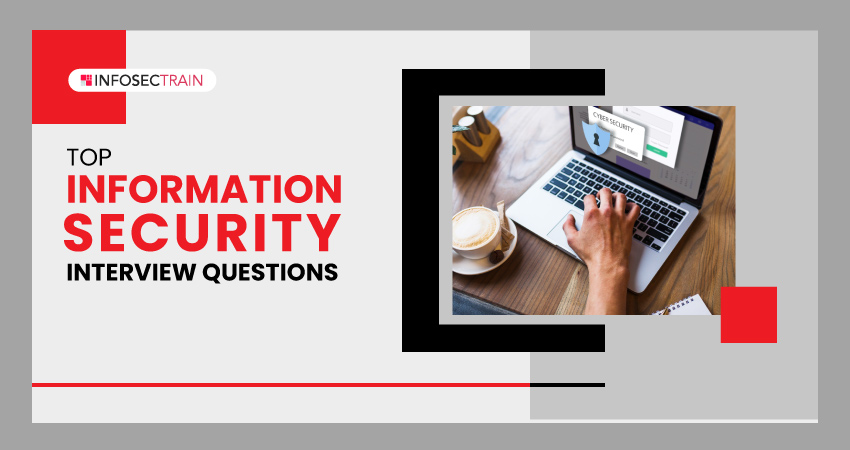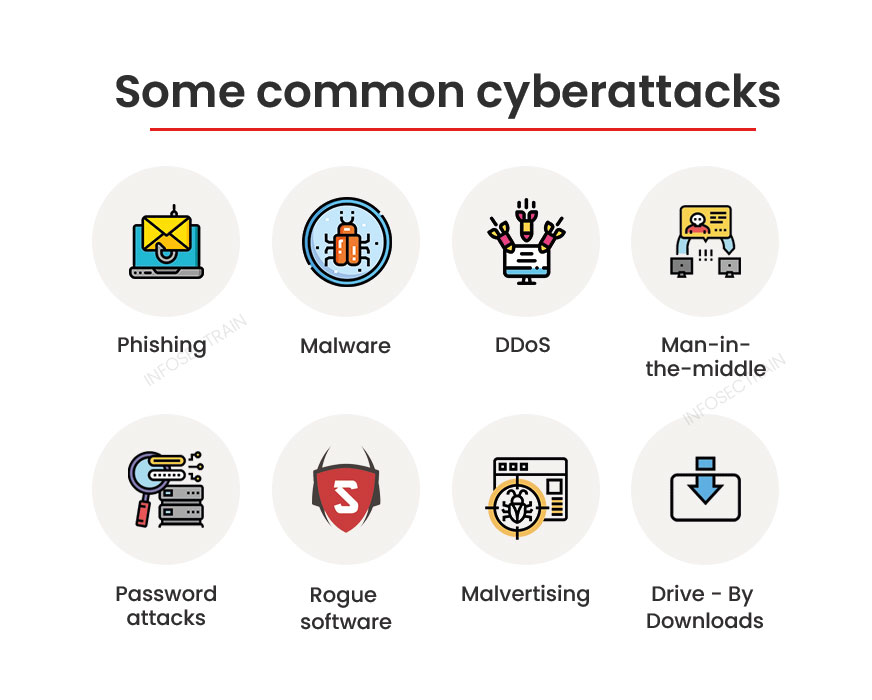Top Information Security Interview Questions
Unauthorized access represents only a part of information security. The primary objective of information security is safeguarding data against unauthorized use, disclosure, modification, or access. Information can be stored using either physical or electronic data. Information security specialists might work for the government, the business sector, or non-profit organizations.

While having the necessary information security skills is the initial step, passing the interview is an entirely different story. Here are some information security interview questions and answers to help you ace the interview.
Interview Questions and Answers
1. Define a firewall.
A firewall, a vital element of network security, regulates both incoming and outgoing traffic to prevent unauthorized access. Operating according to predefined rules, it decides whether to permit or deny specific traffic.
2. What exactly is the CIA triad?
The CIA stands for Confidentiality, Integrity, and Availability. The term “Confidentiality” refers to ensuring that only authorized people can access information. Integrity means preventing unauthorized modifications to information and Availability refers to making information available to authorized users whenever they need a service.
3. What do you understand by regulatory compliance?
Regulatory compliance refers to the adherence of individuals, organizations, or businesses to the laws, regulations, guidelines, and standards set forth by regulatory bodies or authorities governing their specific industry or jurisdiction. It involves following the rules and requirements designed to ensure ethical behavior, safety, security, data privacy, and transparency within a particular field.
4. What is the benefit of using SSH from a Windows PC?
SSH (Secure Socket Shell) is a secure connection employed on various systems and customized appliances. Devices like routers, switches, SFTP servers, and insecure apps are tunneled through this port and are utilized to protect a connection from eavesdropping. SSH protocol is implemented on various systems, though not by default in many Windows. PuTTY, Filezilla, and other programs offer Windows ports, allowing Windows users to access these devices with the same ease as Linux users.
5. Explain SSL and why it is not adequate for encryption.
SSL (Secure Socket Layer) is used for identity verification instead of hard data encryption. SSL facilitates secure and encrypted connections between networked computers. Since practically everyone uses SSL online, it is a large target and is mostly attacked through its implementation. As a result, SSL can be stolen under specific conditions. Hence, extra measures for data-in-transit and data-at-rest are highly recommended.
6. What exactly is a three-way handshake?
A three-way handshake is a technique for establishing a connection between a host and a client in a TCP/IP network. The three-step process used by the client and server to exchange packets is known as a three-way handshake. Here are the steps:
- The client sends a SYN (Synchronize) message to the server to see if it is accessible and if any ports are open.
- The server sends a SYN-ACK message if the client has open ports.
- The client acts by sending the server an ACK (Acknowledgement) packet.
7. What exactly is SNMP?
SNMP is an abbreviation for Simple Network Management Protocol. This protocol provides a foundation for gathering data that will allow us to control, monitor, and modify electronic properties on a network.
8. What are the different kinds of sniffing attacks?
There are two types of sniffing attacks:
- Passive sniffing: When a set of devices or computers are connected to a hub, passive sniffing can be performed. Every host on the network can see traffic through a hub. Therefore, the attacker allows the sniffer to listen to all traffic to the same broadcast domain devices.
- Active sniffing: Active sniffing attacks occur when a device is connected to a switch. In this attack, the attacker intentionally sends malicious traffic onto the network to overload and trick the memory table into diverting traffic to them. This attack can be carried out using MAC flooding, ARP poisoning, and MAC duplicating.
9. What do you mean by UEBA?
User and Entity Activity Analytics, or UEBA, examines user behavior to find unusual actions. It uses cutting-edge analytical techniques like deep learning and machine learning. A UEBA can detect newly created attacks by attackers and zero-day attacks.
10. What are the phases of the cyber kill chain?
The cyber kill chain comprises seven distinct stages, encompassing:
- Reconnaissance: This is the phase in which an attacker observes and scopes a target to find vulnerabilities.
- Weaponization: In this phase, the attacker develops a plan of action or an attack to take advantage of the vulnerabilities identified.
- Delivery: In this phase, attackers send the payload required to carry the attack.
- Exploitation: The attackers exploit the delivered payload or vulnerability at this phase.
- Installation: In this phase, attackers attempt to create a backdoor to gain a foothold.
- Command and Control: In this phase, attackers send commands such as APT code to the network.
- Actions/Objectives: In this phase, attackers achieve their objective of the attack.
11. What are the response codes that a Web Application can provide?
The following are the response codes that a Web Application can provide:
- 1xx – Informational responses
- 2xx – Success
- 3xx – Redirection
- 4xx – Client-side error
- 5xx – Server-side error
12. What do you mean by data leakage?
Purposeful or unintentional data transmission from within the organization to an unapproved outside location is known as data leakage. Data leakage can be divided into three types based on how it occurs.
- Accidental breach: An entity unintentionally sends data to an unauthorized person due to an error or mistake.
- Intentional breach: Data is purposefully sent by the authorized party to the unauthorized party.
- System hack: Data leakage is caused via hacking methods.
13. What types of cyberattacks are more frequent?

14. What can be done to avoid identity theft?
Below are some of the tips to prevent identity theft:
- Use a strong and unique password
- Avoid sharing sensitive information online, particularly on social media
- Buy from well-known and reliable websites
- Install specialized malware and spyware removal software
- Always keep your system and antivirus up to date
15. How can a BIOS setup that is password-protected be reset?
As the BIOS operates before the system boots up, it utilizes its own mechanism to store preferences and settings. A simple reset approach removes the CMOS battery, which causes the memory containing the settings to lose power and its setting.
16. What exactly is LAN port blocking?
LAN port blocking refers to the process of preventing or restricting access to specific ports within a Local Area Network (LAN). Ports are specific communication endpoints used by computers and devices to send and receive data. In a network, different services or applications use designated ports to facilitate communication.
17. What are salted hashes?
Salt is a piece of random data. When an adequately secured password system gets a new password, it generates a hash value of that password and a random salt value and stores the combined value in its database. This aids in the defense against dictionary and known hash attacks.
18. What do you mean by cognitive cybersecurity?
Cognitive cybersecurity uses AI technology to identify risks and defend physical and digital systems by modeling them after human thought patterns.
19. What makes a false positive different from a false negative, and which is worse?
A false positive happens when an alarm is generated for a non-malicious behavior, whereas a false negative occurs when no signal is generated for malicious activity. False negatives are more detrimental than false positives since they suggest malevolent conduct goes unnoticed, whereas a false positive is only an annoyance.
20. Describe traceroute. Why is it utilized?
A tool that displays a packet’s path is called a traceroute. It records every location the packet passes through. This is typically used when a packet does not get to its destination. A traceroute determines where the connection stops or breaks to pinpoint the failure site.
About InfosecTrain
When you are determined to pursue a career in information security, these questions will help you in your interview preparation. These are not the only questions you will be asked during an interview; the difficulty level will vary based on your applied job. InfosecTrain is intended to assist you in your career as an information security specialist. Check out InfosecTrain’s various information security courses to help you improve your knowledge and skills.






 1800-843-7890 (India)
1800-843-7890 (India)